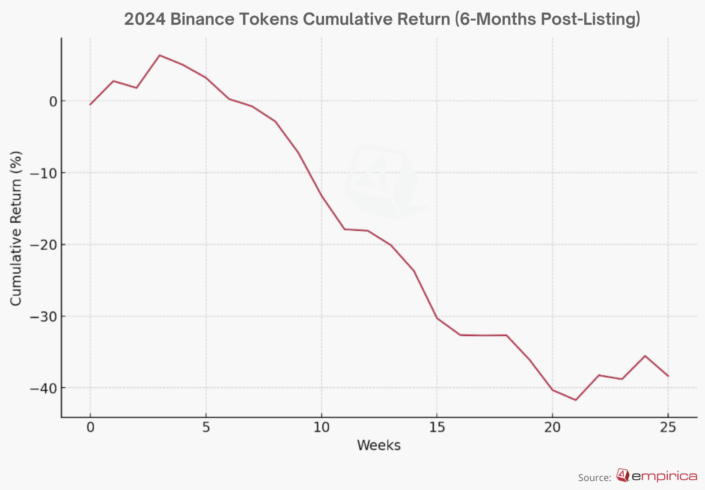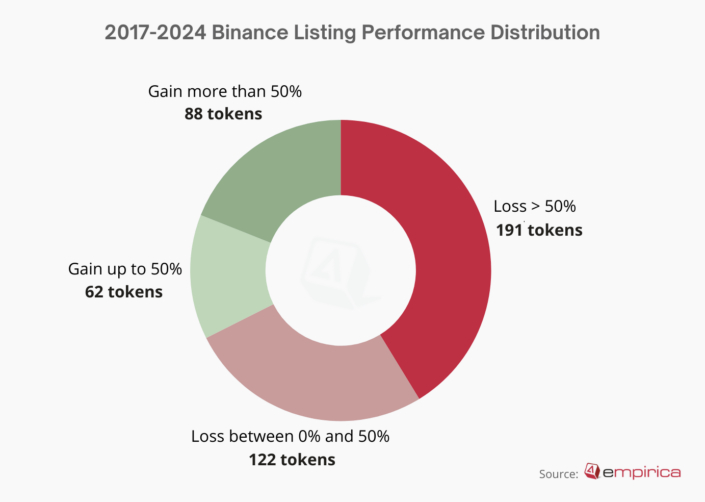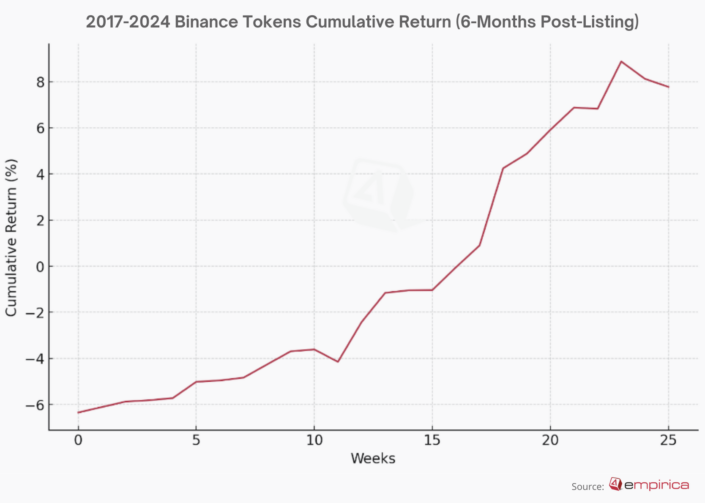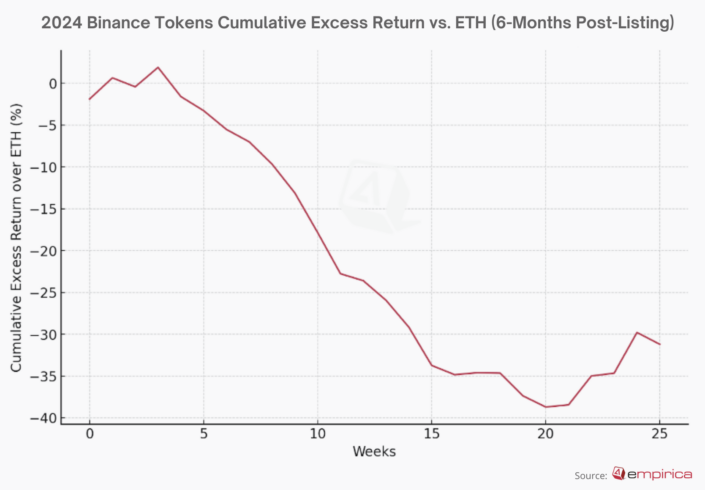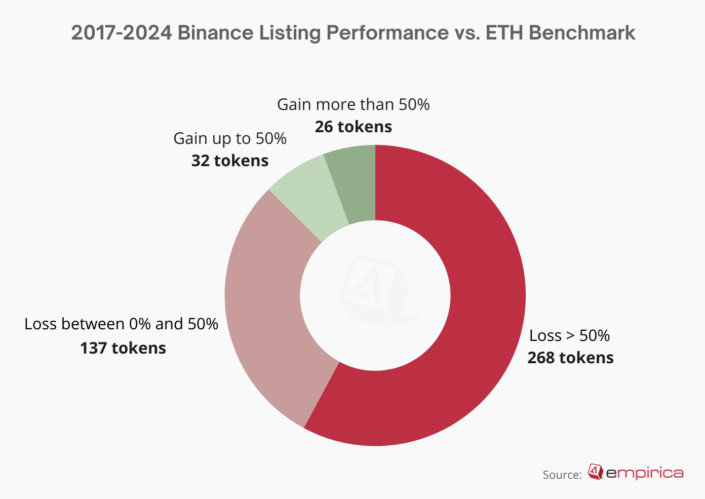The Binance Effect: A 7-Year Analysis For Token Founders
November 8, 2024
In crypto, some things are taken for granted. One is the belief that getting listed on Binance is a major positive milestone in a token’s journey. The logic seems straightforward: the biggest exchange means access to more investors, which should translate into higher market capitalization — the Binance Effect. Based on this assumption, token projects are ready to pay hundreds of thousands of dollars in listing fees.
But do we really understand how the listing on Binance affects token value? Does prestige translate to token capitalization? We analyzed every listing since the exchange’s inception in 2017 to answer this question with data rather than assumptions.
Beyond Opening Day Hype
This year, Binance introduced 44 new instruments (we base our analysis on a Binance dataset). The first striking observation is the dramatic difference between apparent and actual listing success.
If we looked only at returns versus opening price on day one, the average return would be a staggering 1691%. This number is misleading—it stems from artificially low opening prices, which is unfortunate but common among exchanges wanting to showcase “successful” listings. This is especially visible if this is a coin’s initial listing. Let’s discard this metric.
The Current Landscape: 2024 in Focus
The real picture emerges when we look at returns relative to first-day closing prices: next day: +2.78%, first week: +0.40%, first month a bit worse: -1.76%, then it goes down fast – three months: -22.66% and six months: -37.64%.
Only 5.5% of tokens that have completed six months of trading after the listing in 2024 showed positive returns.
Learning from 500+ Listings
Analyzing a large dataset of listings since Binance’s inception (after excluding outliers using the IQR test), the six-month results break down as follows:
- 191 tokens lost more than 50%
- 122 tokens lost between 0% and 50%
- 62 tokens gained up to 50%
- 88 tokens gained more than 50%
Interestingly, we observe a clear selling pattern in the first week after listing. In the first week, prices of newly listed tokens fall by 6.34%. This is likely due to profit-taking by listing speculators, insiders, or the exchange itself selling tokens received as listing fees.
The average price performance after 6 months is 8%. This indicates that after the initial selloff, most tokens rebound. The final score is below expectations, considering listing fees, but ultimately, it is not that bad.
But let’s dig a bit deeper.
Measuring True Performance
Nominal returns don’t tell the whole story. A rising tide lifts all boats, and a falling tide lowers them. To understand the real value added by a Binance listing, we need to compare token performance against the market. We’ll use ETH as a benchmark representing overall market conditions during each token’s first months of trading. While not perfect, it’s reasonable—historically, altcoin correlation to ETH typically ranges between 0.7 and 0.8.
Here is the picture that compares this year’s listings against our benchmark.
The cumulative price change for tokens listed on Binance in 2024 is -31.20% compared to the market, which is a big underperformance. Only one token outperformed the market. This is particularly significant given the bear market in the second half of 2024—even accounting for the general downtrend, newly listed tokens performed significantly worse than the market.
Analysis of all listings versus ETH reveals an even clearer picture of underperformance:
- 268 tokens lost more than 50% to the market
- 137 tokens lost between 0% and 50% to the market
- 32 tokens gained up to 50% to the market
- 26 tokens gained more than 50% to the market
The aggregate six-month performance of all 500 Binance-listed tokens trails the market by -39.46%. This means that if tokens rose, on average, 8% in nominal terms, as we have seen on one of the previous charts, the market grew over 47% in that period.
Intriguingly, token correlation to ETH drops to 0.34 post-listing. This underscores how token trading patterns diverge from the market after listing, unfortunately, not in a positive direction.
Strategic Implications for Projects
These aren’t encouraging findings for projects spending small fortunes on listings.
What might explain this?
The data is public, and investors have drawn their conclusions. A contrarian strategy of selling something that most people expect to rise but which data shows regularly falls makes sense here. Moreover, investors have likely decoded and now anticipate insider behavior. We’ve repeatedly seen Binance listings serve as exit liquidity events for stakeholders. If you can’t profit from tokens rising because someone will dump them on you, you can profit from their decline. But that’s just my speculation.
The data doesn’t say that listing on Binance is always a bad decision. But this year, the only tokens that outperformed the market after the listing were meme coins, which would probably outperform the market anyway. This reveals something important: mere presence on the largest exchange fails to guarantee success and statistically corresponds with significant market underperformance.
Perhaps instead of asking, “How do we get listed on Binance?” projects seeking market cap growth should ask a different question: Are there approaches that cost the project’s treasury less and carry lower risks of negative price impact? Because there are.
But before we explore those, in our next piece, we’ll examine token price behavior before listing. Perhaps that will brighten this rather dark picture of the listing’s impact on token valuation.
Michal



